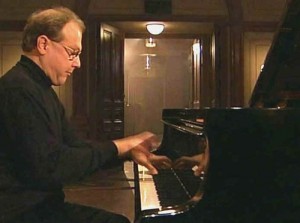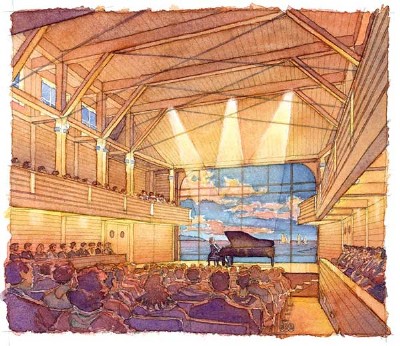Classical Music: Marc-André Hamelin wows at Rockport
By Susan Miron

Pianist Marc-André Hamelin: It sometimes looks like he has cartoon hands, each of his 20 fingers moving in different directions.
Two things of overwhelming beauty—an ocean view and an extraordinary pianist’s recital—nearly generated sensory overload on Sunday in Rockport, Massachusetts’s highly touted new concert hall. Presented by the excellent Rockport Chamber Music Series, now in their fifteenth season under the Artistic Director pianist David Deveau, the late afternoon Sunday concert included music by Alban Berg (1885–1935), Franz Liszt (1811–1886), Claude Debussy (1862–1918), and Marc-André Hamelin himself, born in Canada in 1961, very much alive and playing his customary dazzling best.
For those who somehow missed the deluge of press accolades about Rockport’s brand-new, waterfront Shalin Liu Performance Center, walking into this hall is an experience like few others. Those who have been to Brooklyn’s Bargemusic, in which the audience looks through a huge glass wall past the performers to a backdrop of Lower Manhattan, will perhaps experience a frisson of familiarity. All others, I suspect, will find their jaws dropping. Located between Rockport’s Main Street and, as its principal architect Alan Joslin describes it, “perched proudly on the seawalls that hug the edge of the open water,” this 330 seat hall had the A team of acousticians work on it, (who had worked on Tanglewood’s Ozawa Hall) and it shows, or, rather sounds like it. The acoustics are beautiful.

Shalin Liu Performance Center: Accompanying the music were gulls, swimmers, sailboats, and walkers, a colorful army that thinned out as the hours passed.
Long a champion of arcane works by overlooked and little known composers (Alkan, Henselt, Sorabji, Kasputin, Ornstein, and many more), Marc-André Hamelin deservedly has attracted huge critical acclaim, prizes, and honors. Like the late Glenn Gould, another great Canadian pianist, Mr. Hamelin has played exactly the music he wants to play and, luckily for both us and for the composers, recorded his findings.
At the moment he has made around 60 CDs. Critics have fallen over themselves with superlatives. The New Yorker‘s Alex Ross referred to Hamelin’s hands as “among the wonders of the musical world,” and the legendary New York Times critic Harold Schoenberg called him “a supervirtuoso.” This typecasting annoys this thoughtful pianist who claims he plays simply for the audience’s enjoyment. (The Rockport audience adored him). He feels that being described as “virtuoso” implies a great technique but no soul and feels that being referred to, often, as an intellectual is similarly insulting. It suggests that he is unemotional.
None of this would matter if he weren’t such an exceptional and intriguing artist. Hearing Mr. Hamelin live after listening to a half dozen of his CDs and DVDs, I expected to hear amazing music making. And I did. There is no use at this point in his career fawning over his transcendental technique. Yes, it sometimes looks like he has cartoon hands, each of his 20 fingers moving in different directions. But that is not the point. What’s important is that he can transfix and bewitch, produces an unusually beautiful singing quality when needed, a demonic and humorous side when needed, and the most lyrical left hand I have ever heard.
His program opened with a lovely, early 14-minute sonata by Alban Berg, a rather romantic piece like his early String Quartet. The famous one-movement, half-hour warhorse, Sonata in B Minor by Franz Liszt followed. Apparently, Mr. Hamelin only recently chose to learn this, but as he plays everything as if he owns it, it sounded like he had played it all his life. The sonata, based on three themes, is a dazzling workout that Liszt reputedly didn’t care for very much.
Almost Schumannesque in its frequent and sudden mood swings, the sonata, with its moments of wild virtuosity and ghostly tranquility, was played against a backdrop of a sailboat moving out to sea, out of the windows’ frame. No stranger to piano recitals, I must have heard this piece 50 times, but I never heard the left hand in the final fugue with such clarity and beauty as in this exciting yet lyrical performance. Needless to say, there was a standing ovation.
Intermission was followed by three of Claude Debussy’s dazzling Préludes, Book II, played terrifically. Next came five selections from Mr. Hamelin’s own Twelve Etudes in All the Minor Keys, recently finished and recorded (a CD of it comes out in September). The etudes were as compelling and as varied in their moods and diverse technical challenges as the Liszt and Debussy. There aren’t many new pieces I cannot wait to hear again, but these twelve etudes, which took Mr. Hamelin 25 years to compose, promise serious listening pleasure. Particularly ravishing was his “Etude for Left Hand after Tchaikovsky’s Lullaby” in a spellbinding performance.
After three curtain calls, Mr. Hamelin modestly announced, “Now for something by a real master,” “Garden of Buitenzorg” from The Java Suite by one of the composers he has championed, Leopold Godowski (1870–1938).
The audience was ecstatic. Concerts don’t get much more interesting than this one in Rockport or anywhere else.
———-
Susan Miron is a harpist, book critic, and essayist.
Tagged: Classical Music, Marc-Andre Hamelin, New England, Pianist, Rockport Chamber Music Series

Very interested in this pianist and this concert hall, being great fan of Ozawa Hall in Lenox by the same architect. Can you post more photos of the hall inside and out?
He has 20 fingers? That explains it all!
Brilliant pianist indeed.
Yes — 20 cartoon fingers . . .